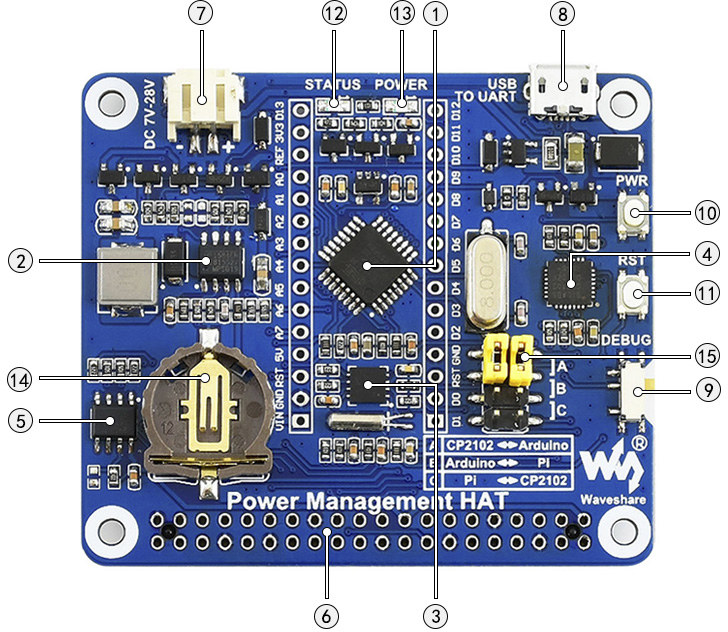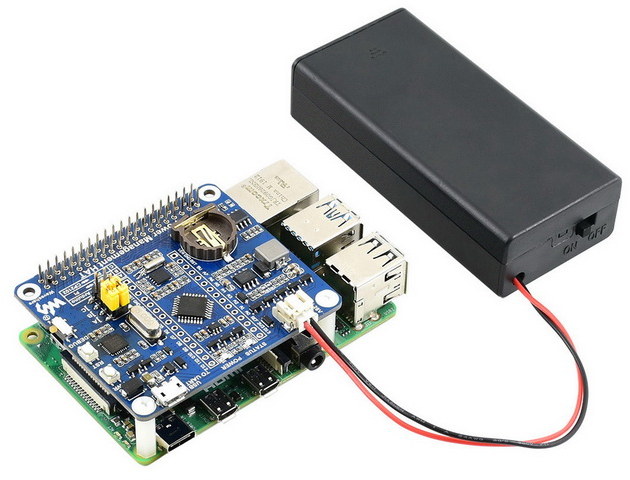If your Raspberry Pi project runs on battery, but may not need to be turned on 24/7 in order to lower power consumption, you’d have to find a way to schedule on and off times, and power off the board cleanly either when the battery is almost depleted, or your timer requires it
There’s no built-in support for this in any of the Raspberry Pi boards, but Waveshare Power Management HAT can help you do just that since it adds an RTC, and enables software-controlled power timers and battery monitoring via an Arduino compatible ATmega328 MCU.
 Power Management HAT specifications:
Power Management HAT specifications:
- MCU – Microchip ATmega328P-AU MCU
- Storage – CAT24C32 EEPROM
- USB – 1x micro USB port for serial communication via CP2102 UART to TTL chip
- RPi Interface – 40-pin Raspberry Pi GPIO header
- Misc
- NXP PCF8523 RTC & calendar chip + CR1220 battery holder
- DEBUG switch (9) to either:
- Power directly Raspberry Pi board
- Let the “Arduino” MCU manage the power supply
- UART selection (15)
- A – Access Arduino via USB to UART
- B – Control the Raspberry Pi by Arduino
- C – Access Raspberry Pi via USB to UART
- Power/User and Reset buttons
- Status and Power LEDs
- Power Supply
- PH2.0 connector for 7~28V regulated power supply or lithium battery
- Monolithic Power MP1584 switching regulator
- Protection circuits such as reverse-polarity, overcurrent, etc…
- Voltage/current monitoring circuits
- Dimensions – 65 x 56.5 mm (Raspberry Pi HAT)

The Power Management HAT ships with a 18650 battery case (for two batteries), a USB-A to USB micro B cable, a 40-pin female header, and screws to attach it to the Raspberry Pi board. Once you’ve added your own 18650 batteries and connected the HAT to your Raspberry Pi 3/4, you’ll need to install and run a script (Power-Management-HAT-Setup.sh) in the board, and flash one of the code samples (ButtonBoot, MeasureCurrent, MeasureVoltage_ShutdownInLowVoltage, etc..) from the Arduino IDE as explained in the Wiki.
Waveshare Power Management HAT can be purchased for $19.99 and up on Amazon, Seeed Studio or directly from Waveshare.

Jean-Luc started CNX Software in 2010 as a part-time endeavor, before quitting his job as a software engineering manager, and starting to write daily news, and reviews full time later in 2011.
Support CNX Software! Donate via cryptocurrencies, become a Patron on Patreon, or purchase goods on Amazon or Aliexpress





Seems like a lot of board for something that can be done by a single cheap PMIC from AXP or Injoinic. From what I can tell the Injoinic ones even have an RTC with oscillator built in.
After a bit of research, I found that most RavPower USB “bricks” will work in pass-through mode, so can act as a UPS. I bought the model type “UK-RP-PB058” which is listed on Amazon as “USB C PD Power Bank 26800mAh Portable Charger 30W Type-C Input and Output External Battery Pack for Nintendo Switch, USB C Laptops, MacBook and More”
[amazon UK code is B07PN36LLW]
To work in pass-through, connect power to the microUSB or USB-C, then the device to an USB-A output. This works fine with a Pi4 using the official R-Pi4 power supply. I was able to run the Pi4 at a high load and the pack still charged from 50% to full.
hopefully this will be useful to others.
p.s. I bought it for under £35 on CyberMonday, so although the price is £55, if you’re not in a hurry it’ll be on sale at a hefty discount sometime.
Did you check if this power bank delivers the power without interruption to Pi during losing/getting back the power from the mains? Most power banks stop power delivery for short time enough to reset the Pi.
I don’t see any chart defining each of the components in this article. It appears only 9 and 15 are mentioned. The wiki has no details either, especially python examples and use. The script only reads on GPIO pin to determine to shutdown the Pi. Where can I get details how to use this board, with python especially? I don’t see what battery to install to enable the RTC feature, if required.